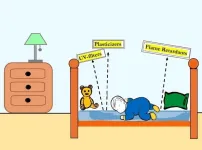Key to the high aggressiveness of pancreatic cancer identified
A study demonstrates the role of the Galectin-1 protein in the nucleus of the cells surrounding the tumor—fibroblasts—contributing to their activation. Activated fibroblasts promote tumor growth and spread, while also conferring resistance to treatmen
2025-04-15
(Press-News.org)
Barcelona, 15th April 2025. – Pancreatic cancer is one of the most aggressive cancers and has one of the lowest survival rates—only 10% after five years. One of the factors contributing to its aggressiveness is its tumor microenvironment, known as the stroma, which makes up the majority of the tumor mass and consists of a network of proteins and different non-tumor cells. Among these, fibroblasts play a key role, helping tumor cells to grow and increasing their resistance to drugs. Now, a study led by researchers from the Hospital del Mar Research Institute, IIBB-CSIC-IDIBAPS, Mayo Clinic, Instituto de Biología y Medicina Experimental (CONICET, Argentina) and CaixaResearch Institute, has identified a new key factor contributing to this feature of pancreatic cancer: a previously unknown function of Galectin-1 protein inside the nuclei of fibroblasts. This discovery, published in the journal PNAS, offers new insights into the role of these cells in the progression of pancreatic cancer.
“The stroma is considered a key component in the aggressive nature of pancreatic cancer, as it interacts with tumor cells, protects them, and hinders the action of drugs. Moreover, stromal cells, particularly fibroblasts, produce substances that support tumor growth and dissemination,” explains Dr. Pilar Navarro, coordinator of the Cancer Molecular Targets Research Group at the Hospital del Mar Research Institute and IIBB-CSIC-IDIBAPS. Until now, fibroblasts were known to secrete Galectin-1, a protein with pro-tumoral properties. This study, however, shows that the molecule is also located inside fibroblasts—specifically in their nuclei—where it plays a key role in gene expression regulation.
The presence of this molecule activates fibroblasts, making them support tumor cell development. The researchers also discovered that “Galectin-1 can regulate gene expression in these cells at a highly specific level without altering the DNA sequence, through epigenetic control. One of the genes it regulates is KRAS, which plays a critical role in pancreatic tumors,” explains Dr. Navarro. This gene is also present in tumor cells in 90% of patients, though in this case it is mutated. It is considered one of the main drivers of uncontrolled growth and tumor aggressiveness.
Designing new strategies
The team behind the study had previously identified the prominent role of Galectin-1 in pancreatic cancer. However, the newly discovered functions now pave the way for developing new strategies to tackle this type of tumor. “Until now, efforts have focused on inhibiting Galectin-1 secreted by the stroma surrounding the tumor. Now, we see that we also need to block the protein inside the fibroblast nuclei,” says Dr. Neus Martínez-Bosch, researcher at the Hospital del Mar Research Institute.“We need to find new inhibitors that work inside fibroblasts, not just on the protein they secrete,” she adds.
To carry out the study, researchers worked with tissue samples from pancreatic cancer patients, allowing them to analyze the presence and function of Galectin-1 in fibroblast nuclei. They also performed in vitro experiments with human fibroblast cell lines, investigating the effects of inhibiting both the protein and the KRAS gene, and observed deactivation of these cells—effectively halting their cooperation with tumor cells.
Dr. Judith Vinaixa, also a researcher at the Hospital del Mar Research Institute and first author of the study, highlights the importance of these results: “We have confirmed the key role of Galectin-1 in the fibroblast cell nucleus, where it regulates the expression of multiple genes critical for cell behavior.”. Dr. Gabriel Rabinovich, researcher at IBYME (CONICET) and the CaixaResearch Institute, adds: “The next steps will involve exploring therapeutic combinations that inhibit both extracellular and intracellular Galectin-1. This protein also participates in key processes such as blood vessel formation and resistance to immunotherapy. Therefore, this strategy becomes particularly relevant given the multiple antitumoral effects of Galectin-1 inhibition.”
The study also involved contributions from the Pathology Department at Hospital del Mar and researchers from the Cancer Area of CIBER (CIBERONC).
Reference article
Vinaixa J, Martínez-Bosch N, Gibert J, Manero-Rupérez N, Santofimia-Castaño P, Baudou FG, Vera RE, Pease DR, Iglesias M, Sen S, Wang X, Almada LL, Marks DL, Moreno M, Iovanna JL, Rabinovich GA, Fernandez-Zapico ME, Navarro P. Nuclear Galectin-1 promotes KRAS-dependent activation of pancreatic cancer stellate cells. Proc Natl Acad Sci U S A. 2025 Apr 8;122(14):e2424051122. doi: 10.1073/pnas.2424051122. Epub 2025 Apr 2. PMID: 40172967.
END
ELSE PRESS RELEASES FROM THIS DATE:
2025-04-15
April 15, 2025 | Portland, Oregon—A new study in the journal Fisheries shows how a salmon-focused ecosystem protection strategy in the North Pacific can deliver meaningful results in the global drive to protect biodiversity.
The approach, called the stronghold strategy, aims to proactively protect the world’s greatest remaining “strongholds”—a select group of salmon, steelhead, and trout systems that collectively comprise 119 distinct watersheds. According to Wild Salmon Center President & CEO Guido Rahr—lead author of the peer-reviewed study—salmonids center the strategy because they are both iconic and globally recognized ...
2025-04-15
Researchers at the VIB-UGent Center for Medical Biotechnology have discovered a promising strategy to improve treatment responses in multiple myeloma patients by blocking a protein that plays a key role in drug resistance. The study, published in Pharmacological Research, offers a potential new strategy to improve outcomes for patients whose disease has become less responsive to standard therapies.
Multiple myeloma (MM) is a type of blood cancer that affects the bone marrow. Patients are often treated with dexamethasone, a synthetic glucocorticoid frequently used in the clinic to regulate immune responses and slow cancer growth. However, as the disease progresses, many patients develop ...
2025-04-15
The sun may rise every morning, but the amount of sunlight reaching the Earth’s surface can substantially vary over decades, according to a perspectives article led by an international research team. The article, published on March 15 in Advances in Atmospheric Science, suggests that stages of “dimming” and “brightening” correspond with increased air pollution and implementation of clean energy solutions, respectively.
“The amount of sunlight — which is solar ...
2025-04-15
People with a certain heart valve abnormality are at increased risk of severe heart rhythm disorders, even after successful valve surgery. This is according to a new study from Karolinska Institutet and Karolinska University Hospital in Sweden published in the European Heart Journal. The condition is more common in women and younger patients with valve disorder and can, in the worst case, lead to sudden cardiac arrest.
Mitral annular disjunction, MAD, is a heart abnormality in which the mitral valve attachment ‘slides’. In recent years, the condition has ...
2025-04-15
The Titanic sunk 113 years ago on April 14-15, after hitting an iceberg, with human error likely causing the ship to stray into those dangerous waters. Today, autonomous systems built on artificial intelligence can help ships avoid such accidents, but could such a system explain to the captain why it was maneuvering a certain way?
That’s the idea behind explainable AI, which should help human actors trust autonomous systems more. Researchers from Osaka Metropolitan University’s Graduate School of Engineering have developed an explainable AI model for ships that quantifies the collision risk for all vessels ...
2025-04-15
In Birmingham, 43% of the population live in the most deprived 10% of neighborhoods in England. It is well known that deprivation can lead to adverse pregnancy outcomes, including low birth weight, premature birth, stillbirths, and neonatal mortality.
Now, researchers there examined the association between demographic, socioeconomic, and lifestyle factors and the risk of adverse birth outcomes in Birmingham and neighboring Solihull, an area much less affected by deprivation.
“Within the study population, there were significant differences in the odds of adverse birth outcomes and the risk factors of adverse birth outcomes by ethnicity ...
2025-04-15
If you’re among the 1.5 billion people worldwide using TikTok, you may have come across exceptional “testimonials” like Nikola Tesla or Marie Curie delivering short science-related messages that have garnered millions of views. This is just one of many examples where AI-generated avatars are used to communicate science — a strategy that might also have its drawbacks.
The generation of images and animations through artificial intelligence is a rapidly growing field, constantly improving in quality. Yet many avatars, though realistic, still present minor flaws — glitches, delays, inconsistent ...
2025-04-15
Newly published research from UNC Greensboro biology professor Dr. Bryan McLean and colleagues shows that the masked shrew, a small, mole-like mammal found in the Appalachian Mountains, shrinks its body and braincase to conserve energy during winter months. The study, published in the May 2025 issue of The American Naturalist, found that the masked shrew (Sorex cinereus) reduces its body mass by 13 percent in the colder months; the creature then grows larger in spring when conditions improve. In addition to a shrinking body, the team also found seasonal changes in the height of the creature’s ...
2025-04-15
Babies and young children may breathe and absorb plasticizers called phthalates, flame retardants, and other harmful chemicals from their mattresses while they sleep, according to a pair of peer-reviewed studies published today from the University of Toronto in Environmental Science & Technology and Environmental Science & Technology Letters. These chemicals are linked to neurological and reproductive problems, asthma, hormone disruption, and cancer.
"Sleep is vital for brain development, ...
2025-04-15
Hoboken, N.J., April 14, 2025 — Tightly connected communities tend to be more resilient when facing extreme events such as earthquakes, hurricanes, floods or wildfires, says Jose Ramirez-Marquez, who develops metrics to analyze, quantify and ultimately improve performance of urban systems.
Ramirez-Marquez, associate professor and division director of Enterprise Science and Engineering at Stevens, who grew up in the earthquake-prone Mexico City knows this first-hand. “Whenever there's an earthquake, a city-wide alarm goes off and everybody leaves wherever they are and stays in the middle of the street — that’s a prevention phase,” he says. ...
LAST 30 PRESS RELEASES:
[Press-News.org] Key to the high aggressiveness of pancreatic cancer identified
A study demonstrates the role of the Galectin-1 protein in the nucleus of the cells surrounding the tumor—fibroblasts—contributing to their activation. Activated fibroblasts promote tumor growth and spread, while also conferring resistance to treatmen



